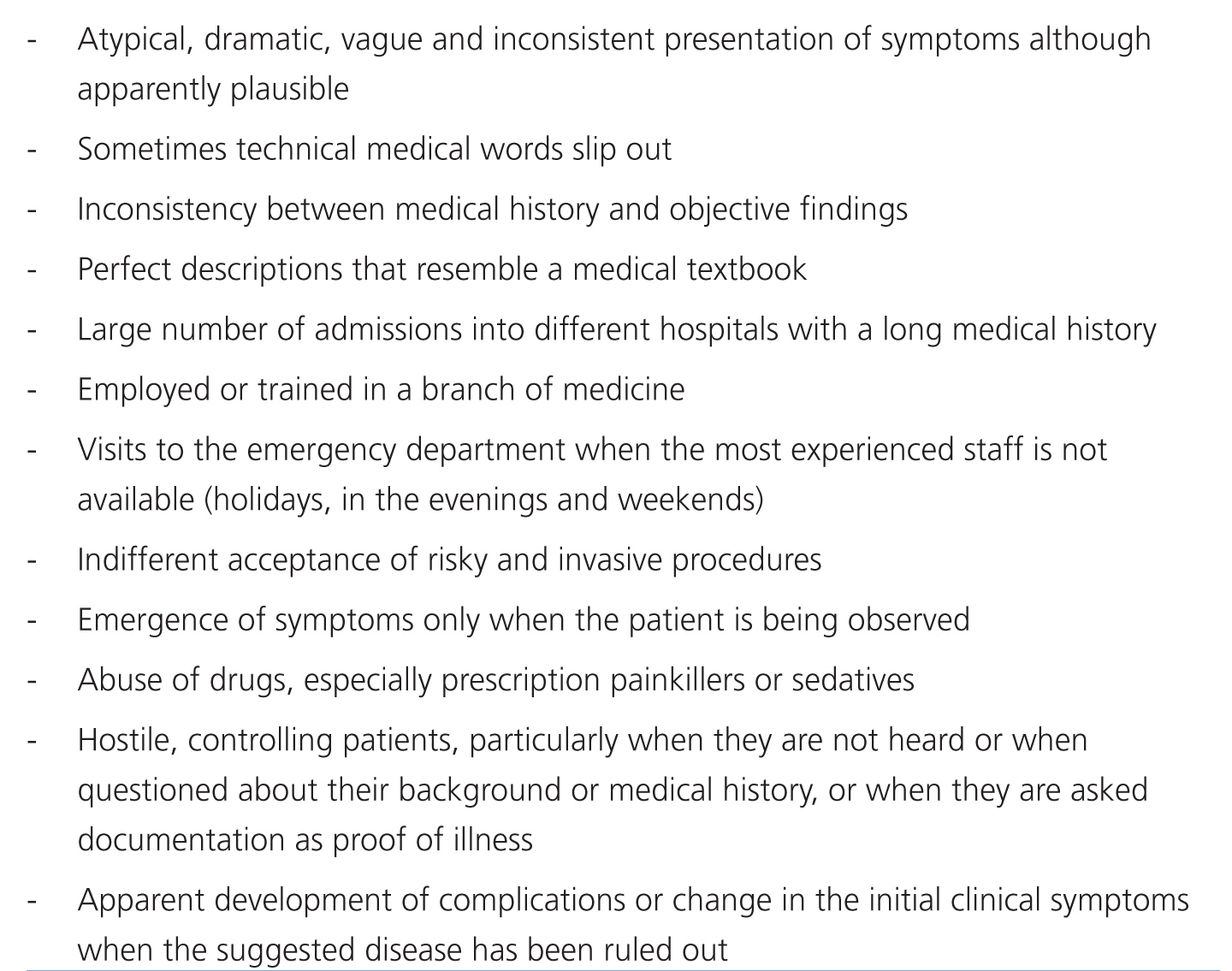To the Editor,
Factitious disorders (FD) and malingering (M) include people who, deliberately, pretend or produce diseases to assume the role of sick, portraying symptoms or signs that may be physical, psychological or both.1 On FD there is no demonstrable external incentive and this practice is more predominant in women. Malingering patients look for a secondary gain and it is more frequent in men.2 Both disorders may be difficult to distinguish and overlap. Sometimes they are called Munchausen syndrome (SM)3 and, although the syndrome has not been formally included as a mental disorder,1 it is widely known in medicine. It includes: 1) A factitious chronic disease, which can be severe and disabling; 2) the pilgrimage: individuals change hospitals, cities or country when their objectives are unsuccessful or discovered; 3) pseudologia fantastica: amazing stories are described with complete certainty. Cases have been described in which parents have made their children sick to reap benefits.4
We present the case of a 31-year-old nurse on haemodialysis with a permanent pacemaker due to tachycardia/bradycardia syndrome and chronic kidney disease with not well-defined cause, who had been diagnosed a year prior. She checked in at the emergency department reporting fever with chills, anuria and general discomfort.
Physical examination confirmed absence of blood pressure (BP) or pulse in the upper limbs, skin pallor and signs of mild dehydration. Heart rate: 118 beats/min, respiratory rate: 24 breaths/min and temperature of 38.5°C. The haemodialysis catheter showed signs of infection in the insertion site (it was withdrawn and cultured). The rest of the physical examination was normal, with a preliminary diagnosis of septic shock by catheter infection. The treatment included vasopressors and antimicrobials and patient was moved to the intensive care unit (ICU).
Upon arrival to the ICU the adequate skin perfusion contrasted with the diagnosed septic shock. There was no BP in the upper limbs, since arteriovenous fistulae had been created in the forearms without reaching flow, but the lower limps showed a BP of 150/90mm Hg, so the vasopressor treatment was terminated. The patient refused to have a bladder catheter placed. The initially diminished central venous pressure was normalised with hydration and a wide and clear diuresis was recovered.
The analysed found: leukocytosis (18x109/l), anaemia (108g/l) and high serum creatinine (158µmol/l). Other complementary studies, including arterial blood gasometry, ionogram, glycaemia and urine sediment, gave results within the normal limits. The ultrasound showed kidneys and urinary tract of normal size and echogenicity. On the third day, creatinine levels had already reached normal values and there was no evidence of kidney disease. Blood cultures with methicillin-resistant Staphylococcus aureus were performed.
Faced with the evidence, MS was strongly suspected and psychological assessment was requested. In the interview, the patient cooperated but refused to undergo a psychometric evaluation and denied having faked the symptoms or altered samples.
The patient's profession (nursing) allowed her to carry blood samples to the laboratory, where she supposedly would add a few drops of urine to raise the levels of creatinine significantly. On many occasions haemodialysis was not concluded due to "discomfort". Patient always refused to undergo a renal biopsy, despite it being appropiate.5 It is speculated that the dysrhythmia could have been caused by self-prescription heart-rate altering drugs and that arteriovenous fistulae were damaged by the patient.
Days later, she was withdrawn from the haemodialysis programme. To date, she remains asymptomatic and has re-joined social life. Motives could not be determined with certainty.
There are certain criteria that allow us to suspect MS (Table). The diagnosis must be done with caution, because a mistake can be fatal. Psychological treatment depends on personality type and the likely aetiology, although in most cases the patients evade treatment.2
Mortality rates may be high due to body self-manipulation, complications of procedures, and hiding important medical information; besides, when they really become ill, these patients can be ignored because of their history.6
In conclusion, MS should be considered in any patient with inconsistencies between their symptoms and the clinical tests. Although it is a rare disease, its diagnosis is essential for the serious consequences that it can cause on the patient.
Conflicts of interest
The authors affirm that they have no conflicts of interest related to the contents of this article.
Table 1. Main observations that point towards malingering and factitious disorders








